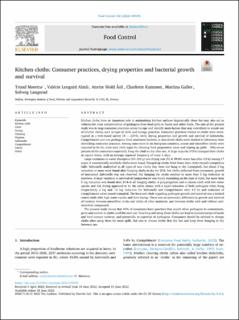| dc.description.abstract | Kitchen cloths have an important role in maintaining kitchen surfaces hygienically clean but may also act as vehicles for cross contamination of pathogens from food spills to hands and other foods. The aim of the present study was to map consumer practices across Europe and identify main factors that may contribute to unsafe use of kitchen cloths, such as type of cloth and storage practices. Consumer practices related to cloths were investigated in a web-based survey (N = 2394), while drying properties and growth and survival of Salmonella, Campylobacter and non-pathogenic food associated bacteria in inoculated cloths were studied in laboratory tests mimicking consumer practices. Among consumers in six European countries, cotton and microfiber cloths were reported to be the most used cloth types for cleaning food preparation areas and wiping up spills. . Fifty-seven percent of the consumers reportedly hang the cloth to dry after use. A large majority (72%) changed their cloths at regular times, with an average reported frequency of every 6 days. Large variations in water absorption (63–201 g) and drying rate (31.8–99.8% water loss after 4.5 h) among 17 types of commercially available cloths were found. Hanged up cloths dried faster than cloths stored crumpled as balls. Salmonella multiplied in all types of new cloths that were not hung to dry (crumpled), but about 3 log reduction or more were found after hanging cloths to dry for 24 h. For cloths collected from consumers, growth of inoculated Salmonella was not observed, but hanging the cloths resulted in more than 3 log reduction in numbers. A large variation in survival of Campylobacter was found depending on the type of cloth, but more than 5 log reduction was found after 24 h in all hanging cloths. A polypropylene and a viscose cloth with low water uptake and fast drying appeared to be the safest choice with a rapid reduction of both pathogens when hung (respectively 2 log and >6 log reduction for Salmonella and Campylobacter after 4.5 h) and reduction of Campylobacter when stored crumpled. The least safe cloth regarding pathogen growth and survival was a knitted cotton cloth with high water uptake and slow drying. There was no systematic difference in growth and survival of bacteria between microfiber cloths and cloths of other materials, nor between cloths with and without antimicrobial compounds. The present study shows that 16% of consumers have practices that would allow pathogens to contaminate, grow and survive in cloths until the next use. Touching and using these cloths can lead to contamination of hands and food contact surfaces, and potentially to ingestion of pathogens. Consumers should be advised to change cloths after using them for meat spills, but also to choose cloths that dry fast and keep them hanging to dry between use. | |
